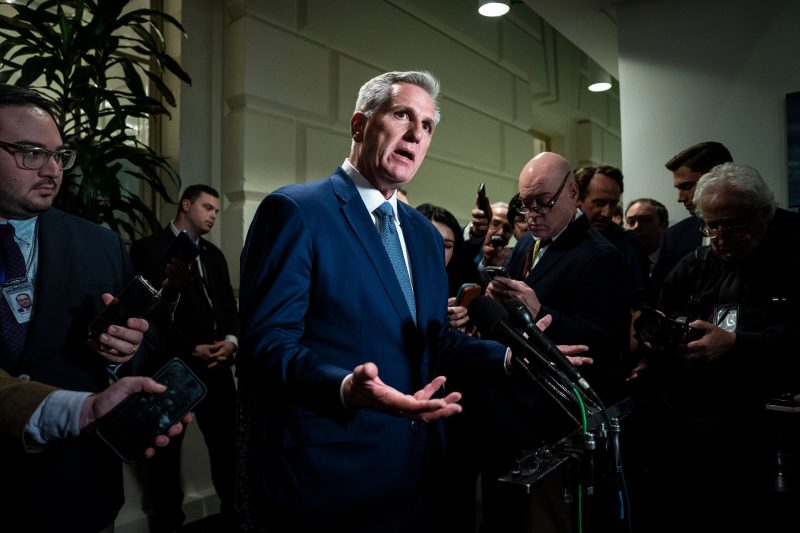“We have to destroy Hamas, but you cannot do it without confronting Iran. They need to change their policies. Iran only had $4 billion in the foreign exchange when [Biden] took office. They now have $70 billion. Iran only produced 400,000 barrels of oil a day when they — when Biden took office. They now produce 3 million. They’re getting billions of dollars to fund terrorism around the world.”
— Rep. Kevin McCarthy (R-Calif.), remarks on NBC’s “Meet the Press,” Oct. 22
“What is so infuriating is, over the last 2½ years, Joe Biden and the Biden administration have flowed nearly $100 billion to Iran. … The biggest pot of money deals with the refusal of the Biden administration to enforce oil sanctions. U.S. law puts tough oil sanctions on Iran. Biden came in, immediately stopped enforcing them. Today, Iran is selling 2 million barrels a day of oil. That has produced $80 billion, roughly, in revenue. That is funding these Hamas death squads. That is funding the rockets. That is funding terrorism.”
— Sen. Ted Cruz (R-Tex.), remarks on “Sunday Morning Futures,” Oct. 22
Since the Oct. 7 Hamas attack on Israel, Republicans have suggested that Biden administration policies toward Iran somehow financed the assault.
Originally, Republicans focused on the release of $6 billion in Iranian funds that had been held by South Korea — released in a deal to win the freedom of five American detainees — but that money had not yet been received by Iran. After the Hamas attack, the administration said it had prevented Iran from tapping the money.
So now there is a new talking point: that Iran has earned far more money from oil sales under President Biden than it did under President Donald Trump, and that, in turn, has funded terrorism. As Cruz put it in his television interview, “Understand, Hamas is a proxy for Iran. Without Iran, there would be no Hamas.”
For context, we should note that there is no evidence that Iran, which has suffered economically from sanctions over its nuclear program, is sending billions of dollars to Hamas. Trump’s State Department calculated in 2020 that Iran sends Hamas $100 million a year. So far, there is no report showing that the amount of funding from Iran to Hamas has increased under Biden.
Yet the administration’s policies certainly are fair game. Let’s evaluate whether the numbers cited by McCarthy and Cruz are correct and what, if anything, can be attributed to Biden’s policies.
The basic thrust of both comments is that, during Biden’s presidency, Iran has benefited economically. McCarthy’s numbers are mostly wrong, and Cruz’s appear exaggerated. But there is little question that Iran — the world’s third-largest holder of oil reserves and the second-largest of natural gas — is able to sell more petroleum products than it was during the later part of the Trump administration.
McCarthy — the former House speaker, whose spokesperson did not respond to requests for comment — said that “Iran only had $4 billion in the foreign exchange when [Biden] took office. They now have $70 billion.” We traced those numbers to a social media post by Robert Greenway, who had been a Trump White House official involved in Iran policy and is now at the Heritage Foundation. He pointed us to a 2021 International Monetary Fund report showing that Iran’s foreign reserves in 2020, during the covid pandemic, were $6 billion. (So McCarthy was in the ballpark with $4 billion.)
But for 2023, the IMF estimates that Iran’s foreign currency reserves are $21.1 billion, not $70 billion. Greenway did not respond to a question about why he said it was $70 billion now.
The IMF also has an updated estimate for Iran’s foreign currency reserves in 2020: $13.8 billion. So rather than an increase to $70 billion from $6 billion — more than 1,000 percent — the foreign currency reserves have grown about 50 percent, to $21.1 billion from $13.8 billion. The IMF estimates that the reserves will be $24.3 billion in 2024. An Iranian central bank official this month attributed the increase to the growth of oil and non-oil exports.
Iran’s reserves were $122.5 billion in 2018, according to the IMF, before new sanctions were imposed after Trump pulled out of an international agreement to restrain Iran’s nuclear ambitions. Without success, Biden has sought to restore the Obama-era nuclear deal with Iran — a policy that itself is a signal to oil markets that sanctions could soon be waived.
As for Iran’s current oil production, McCarthy said Iran was producing 3 million barrels a day and Cruz said Iran was selling 2 million barrels a day. Both numbers are correct, according to SVB International, a consulting firm. Mohsen Khojastehmehr, chief executive of the National Iranian Oil Company, said in August that Iran would soon be producing 3.5 million barrels a day.
But McCarthy gilds the lily by referencing 400,000 barrels a day in 2020.
First of all, that’s a number for oil exports, not production, so he’s mixing apples and oranges. According to the U.S. Energy Information Administration, Iran’s oil production in 2020 was just under 2 million barrels a day. Second, the pandemic sent oil production and sales plummeting around the globe. Iran’s production in 2020 was the lowest in almost 40 years, the EIA said.
In 2019, before the pandemic, Iranian oil production was about 2.6 million barrels a day until May of that year, when sanctions waivers expired, and then fell to 2.1 million. As for exports, Iran sold about 600,000 barrels a day in 2019.
So clearly Iran had begun to sell more oil. Cruz, in his comments, directly implicates the administration: “U.S. law puts tough oil sanctions on Iran. Biden came in, immediately stopped enforcing them.”
Patrick Clawson, director of the Washington Institute for Near East Policy’s program on Iran and U.S. policy, said that’s not quite right. He said the Trump administration was unusually aggressive — a top State Department official even directly contacted the captains of tankers carrying Iranian oil, offering millions of dollars if they would deliver the cargo to a neutral port — but he said in general, sanctions erode over time.
“It would have been tough for a second-term Trump administration to maintain the same level of effort as the first term,” he said.
In particular, China has become adept at evading U.S. sanctions by arranging for many buyers of Iranian oil to be small, semi-independent refineries known as “teapots.” Such entities accounted for about one-fifth of China’s worldwide oil imports, according to Reuters. “With their small size and limited business operations, teapots are both hard to uncover and not exposed to the U.S. financial system,” according to a report last month by the advocacy group United Against Nuclear Iran.
The group estimated that Iranian oil sales to China totaled $47 billion in 2021 and 2022.
“With China’s increasing imports of Iranian petroleum, Chinese buyers may have concluded that the economic benefits of continuing to buy Iranian petroleum exceed the risks of potential U.S. sanctions,” the Congressional Research Service said in a report this week. It noted that China is able to obtain Iranian oil often below prevailing market prices.
Philip Verleger, an economist and energy consultant, said sanctions cannot be sustained unless a large number of countries are participating — and even then they will weaken over time. “The oil is going to move,” he said, unless the U.S. Navy starts boarding tankers.
The Biden administration rejects the idea that it is not enforcing sanctions. A Treasury Department official said an administration diplomatic campaign has ensured there are no new buyers of Iranian oil — he said sales are made to the same buyers that evaded sanctions under Trump — and thus Iran has been forced to rely entirely on black-market oil sales with a steep price discount.
The United States has also seized nearly 5 million barrels of petroleum product, he said. Last month, the Justice Department announced the first criminal resolution involving the illicit sale and transport of Iranian oil in violation of U.S. sanctions. In this case, nearly 1 million barrels of seized oil was tied to the Islamic Revolutionary Guard Corps, which the State Department has designated a foreign terrorist organization.
Cruz said that “over the last 2½ years, Joe Biden and the Biden administration have flowed nearly $100 billion to Iran.” We asked a spokesman for data to back up that figure but did not get a response.
It’s possible that Cruz was referring to an estimate this month by the conservative Foundation for Defense of Democracies (FDD). The organization said that Iran, because of “lax sanctions enforcement,” has earned $95 billion in oil revenue. The report attributed about $32 billion to relaxed or unenforced sanctions.
“Markets respond to signals, be they political and economic,” said Behnam Ben Taleblu, co-author of the report. “Over a year and a half of unenforced oil sanctions meant that when enforcement began, however sporadically, in May 2022, the market did not see this as a measure of seriousness. Iran’s climbing export volumes means Tehran didn’t either.”
The Daily Signal, the news website for Heritage, estimated that Iran has received about $71 billion more under Biden than it would have received under Trump. That estimate relies in part on the assumption that it “stands to reason” that a second Trump administration would have succeeded in keeping oil steady at $55 a barrel. That dubious assumption boosts the $32 billion estimated by FDD to $52 billion. (Monthly oil prices per gallon under Trump ranged from a low of $15.18 per barrel in April 2020, early in the pandemic, to a high of $67 in July 2018, according to the EIA.)
Tyler O’Neil, the author of the Daily Signal estimate, said in an email that “it is, of course, impossible to predict exactly how oil prices would have changed had Trump remained president,” but he faulted Biden’s policies for contributing to higher oil prices. Under Biden, oil reached a high of $113.77 in June 2022, after the Russian invasion of Ukraine. Prices dropped to the $70 range in May and June but have spiked after the Israel-Gaza war erupted.
There are several problematic elements to these statements. The numbers are off, especially McCarthy’s, and they exaggerate the extent to which Iran had managed to boost its oil sales and foreign exchange reserves. Cruz all but says that the Biden administration is responsible for all the money Iran has received from oil sales, when it’s virtually impossible to cut off a major oil exporter from worldwide markets. If you accept the FDD report, the figure that might be attributable to Biden’s sanctions policies would be $32 billion. That’s a big number, but not as high as $100 billion.
Whether any of these earnings can be traced to the funding of the Hamas attack on Israel is still unknown, but Iran makes no secret of its backing of the group.
We find ourselves on the cusp between Two and Three Pinocchios. McCarthy’s figures are so wrong that they are worthy of Three Pinocchios, but as a general matter, it is correct that Iran has recovered from the nadir of oil sales during the pandemic and now is selling more oil than before Trump imposed sanctions. Whether Biden is entirely to blame for that is up for debate, but Republicans could make that case without resorting to exaggeration. So we award Two Pinocchios.
(About our rating scale)
Send us facts to check by filling out this form
Sign up for The Fact Checker weekly newsletter
The Fact Checker is a verified signatory to the International Fact-Checking Network code of principles








